There aren’t many people who would not marvel at the sight of lilies.
These flowers have large, attractive blooms which add a touch of elegance to gardens and yards. Lilies are grown from bulbs and require minimal care, provided you plant them under the right conditions.
There are different varieties of white lilies, and they are sought after for their beauty and elegance. They may also be sought after for cultural purposes since they symbolize various concepts in different cultures.
If you love white flowers and love lilies, you will find the flowers on this list fascinating enough for your garden.
Table of Contents
Madonna Lily

Madonna lily is a classic white lily indigenous to the Middle Eastern region. People have been cultivating it for food and show for over 2000 years.
Madonna lilies have broad crisp white petals, which sometimes have a pale green center. Each flower of the Madonna lily measures around 2-3 inches long, and they produce a lovely fragrance.
You can plant Madonna lilies in your borders, flowerbeds, or rock gardens. They prefer well-drained soil and areas with full to partial sunlight exposure.
Madonna lilies are hardy in USDA growing zones 6-9.
How to Care for Madonna Lily
Plant Madonna lily bulbs in early fall in groups of three. Ensure you space them 6-12 inches apart, covering their tops with an inch of soil.
Remember to plant Madonna lilies away from other lilies because they pick up viruses from other plants with ease.
After planting, water your Madonna lilies adequately. By spring, flowers and foliage will emerge, and they typically require very little care.
The soil should be kept moist but do not overwater. Overwatering may leave the roots soggy, causing root rot.
Oriental Lily
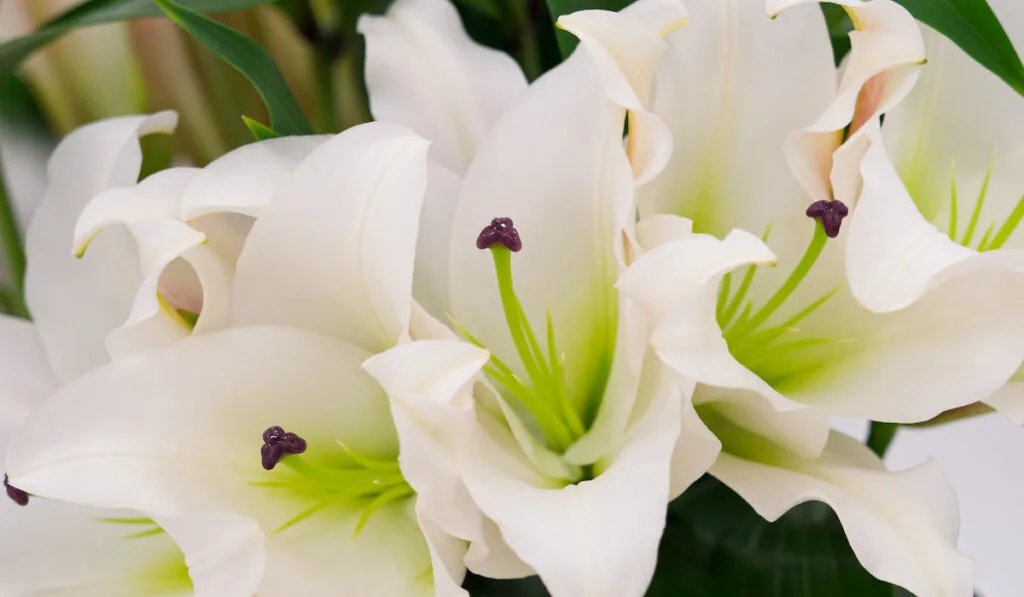
Originally from Japan, the Oriental lily is one species to consider if you intend to have lilies flowering over a long period.
They are one of the few lily species that flower late. Blooms of the Oriental lily begin to appear at the start of autumn.
The pendant flowers of the Oriental lily are either white or pink and are well spaced along the narrow stems. Each bloom of the Oriental lily has dark pink spots and raised papillae bumps.
When they mature, Oriental lily reaches heights of around 4-5 feet. It is found in USDA growing zones 5-7.
How to Care for Oriental Lily
Once Oriental lily bulbs bloom, ensure they are kept moderately moist.
Mulch over the soil base to ensure the soil remains cool and moist. Ensure Oriental lilies receive at least 8 hours of sun each day, and when the blooms begin to fade, cut off the flower stalks.
Golden-Rayed Lily
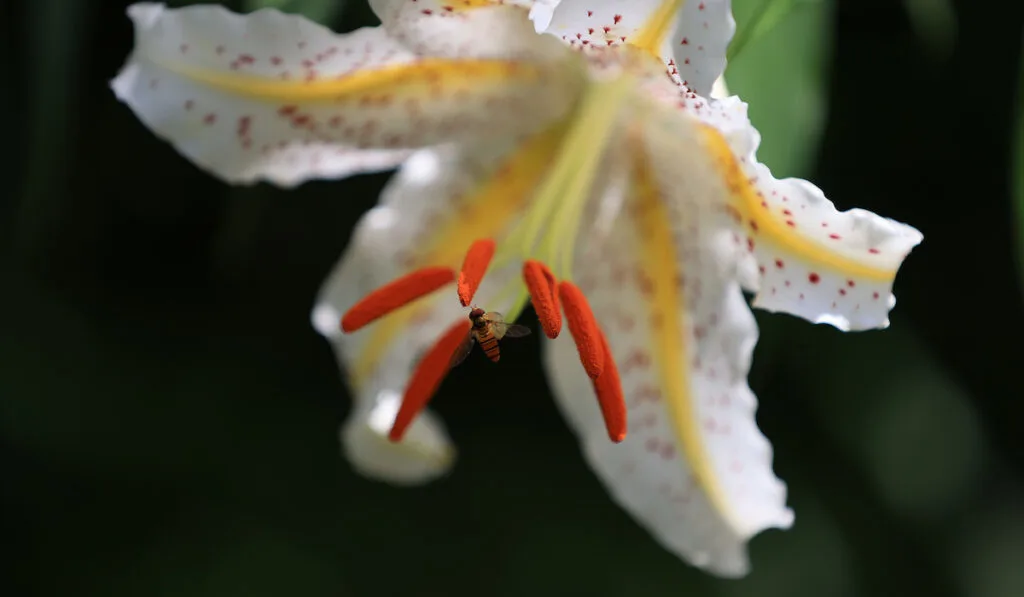
The Golden-Rayed lily is a fragrant and showy plant indigenous to Japan. Its wide-open blooms, which often reach 10-12 inches in diameter, are stunning.
The soft white petals of the Golden-Rayed lily have yellow stripes at the center, giving it that star effect. Some varieties of the Golden-Rayed lily have soft pink tones, while others have small dark spots scattered across each petal.
When planted in a border, Golden-Rayed lilies prefer acidic to neutral soil. They will thrive in containers provided there is enough compost and grit for drainage. When they mature, Golden-Rayed lilies reach heights of up to 3-4 feet.
The Golden-Rayed lily is found in USDA growing zones 5-10.
How to Care for Golden-Rayed Lily
Golden-Rayed lily requires moist, well-drained soils and should be placed in areas with full to partial sunlight exposure.
As the flowers fade, you can remove them to keep the seed from setting. After its bloom, cut the plants back after the stems and leaves have turned yellow.
Easter Lily
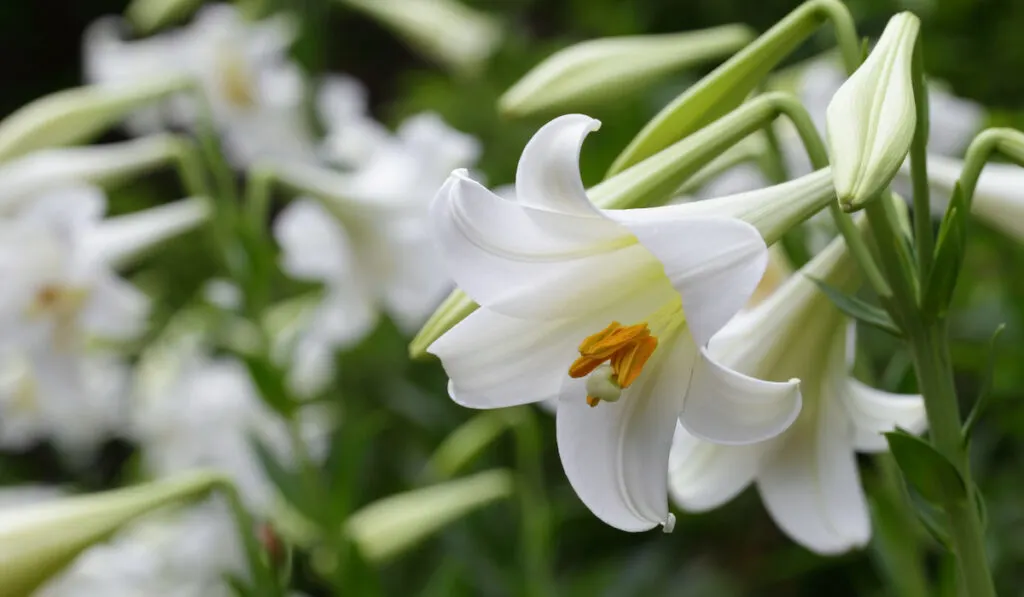
Easter lilies were used as a parent plant to create hybrids like ‘White Heaven’ and ‘White American’. They are pure white, elegant trumpet flowers that bloom outdoors in late summer.
People who stay in warm climates can grow Easter lilies outdoors. But in colder climates, you have to grow Easter lilies under glass. You can also plant them in containers and bring them indoors during winter.
When they mature, Easter lilies are about 2-4 feet tall. They are usually found growing in USDA zones 5 to 8.
How to Care for Easter Lily
When indoors, keep Easter lilies near a window with indirect bright light.
You need to also protect it from heat sources like heaters and cold drafts. If you wrap your pot with foil, check it regularly to ensure that water does not collect underneath it.
When planted outdoors, place Easter lily bulbs 4-6 inches deep with 1 foot of spacing between them.
Ensure the soil surrounding the bulbs does not dry out, but you should not overwater the plant. Also, ensure the soil is well-drained to avoid root rot.
Once your Easter lily reaches a certain height, it will require staking. Most times, potted plants do not grow as tall as they can. So staking is not always necessary.
Once the flowers fade and wither, remove them immediately. Cut down the stem up to the soil once flowering is complete and the leaves & stem have turned yellow.
‘White American’
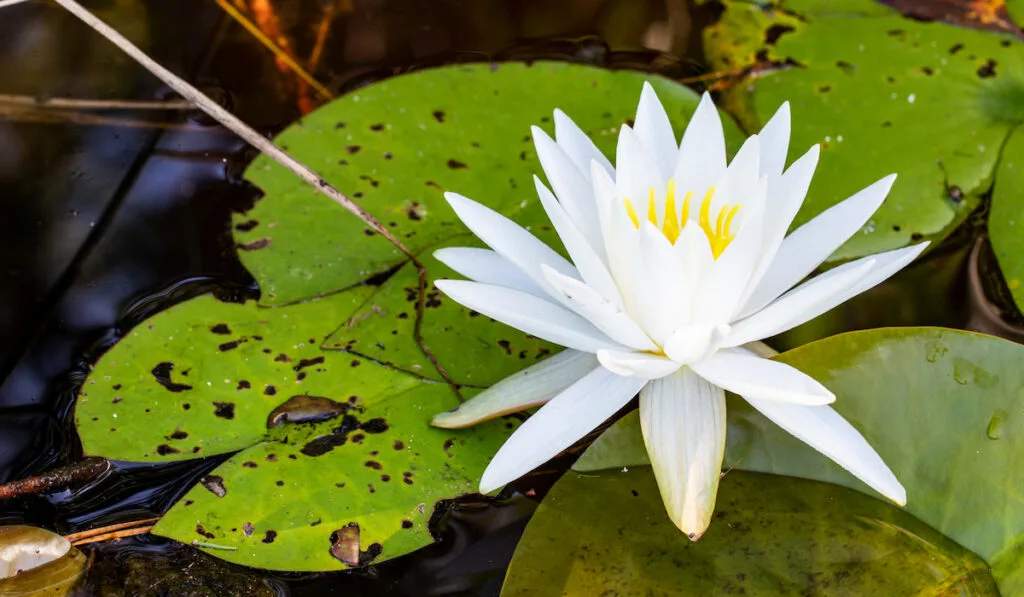
‘White American’ lily is a trumpet lily that is both fragrant and elegant. Unlike the Easter lily, ‘White American’ is hardy and grows well in the right conditions. Plus, it attracts both butterflies and bees.
When they bloom in the summer, the trumpet-shaped white blossoms of the ‘White American’ are large, reaching up to 5 inches across. It also has slightly curved petals that reveal deep yellow anthers and pale green tips.
The upright stems of the ‘White American’ bear lance-like, dark green leaves. On reaching maturity, the ‘White American’ would have grown around 3-4 feet tall.
How to Care for ‘White American’
‘White American’ lilies should be placed in areas with full to partial sunlight exposure. The soil must be moist, well-drained, and must not dry out.
Although the stems of the ‘White American’ are sturdy, they may require staking. Once the flowers fade and wither, remove them immediately. Cut down the stem to the soil once flowering is over and the leaves and stem have turned yellow.
‘Bright Star’

‘Bright Star’ lilies have bold and big white flowers with a splash of orange at the center of the flowers. They get their name from the resulting star-like effect the splash creates.
The shape of a ‘Bright Star’ flower is flatter than the other trumpet lily varieties. When you take a closer look at the blooms of a ‘Bright Star’, you will notice a small light green star within the golden star formed by nectary furrows.
‘Bright Star’ lilies begin to blossom from late summer to early autumn. At maturity, they typically reach heights of 3 to 4 feet. They are found in USDA growing zones 4-9.
How to Care for ‘Bright Star’
Plant ‘Bright Star’ lilies in areas where they will receive maximum exposure to sunlight. The soil should be kept evenly moist but not overwatered or dried out.
Mulch around the base of the plant to keep the root zone cool. Once the flowers fade, remove them to prevent the seed from setting.
‘Casa Blanca’
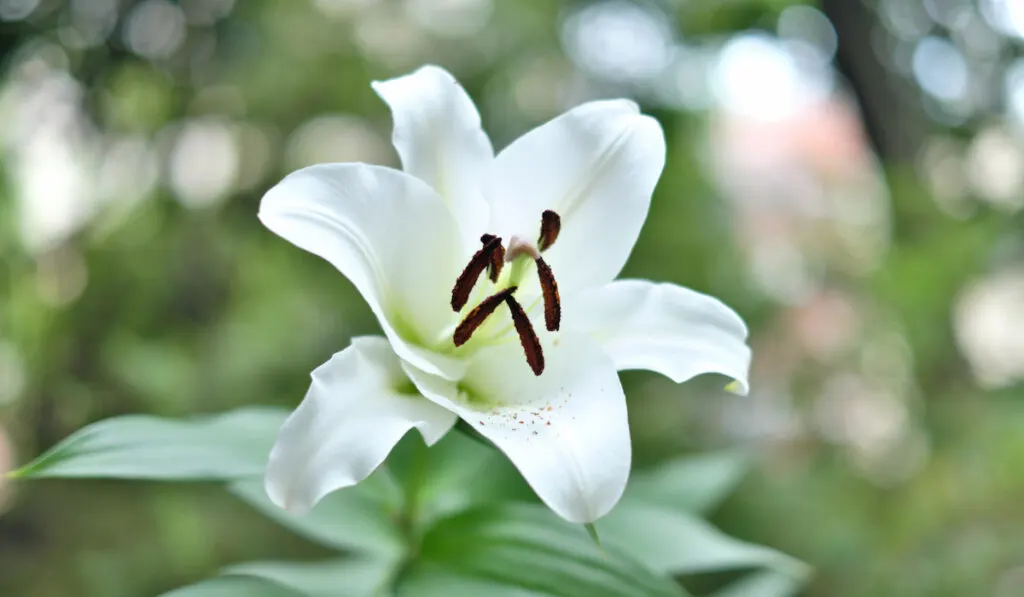
‘Casa Blanca’ is found all over North America and Europe and is a well-loved oriental lily hybrid. It has gorgeous flowers which bloom from mid to late summer. ‘Casa Blanca’ is easy to grow, and its large leaves have a sweet fragrant smell.
Each flower of a ‘Casa Blanca’ lily has six beautiful white petals with reddish-brown anthers. As the flower blooms, the petals begin to curl outwards.
‘Casa Blanca’ lilies are exceptional when used in bridal bouquets by florists. They are found in USDA growing zones 4-9.
How to Care for ‘Casa Blanca’
‘Casa Blanca’ lilies require moist, well-drained soil. If the soil does not drain well, plant the bulbs in a raised bed.
Mulch the base of the plant to keep the roots moist and cool.
Water regularly to ensure the soil remains moist and do not let it dry out. Avoid overwatering as these plants do not like soggy conditions. Fertilize ‘Casa Blanca’ every two weeks during its growing season.
If you anticipate a cold winter dig up the bulbs and take them indoors.
‘Dizzy’
‘Dizzy’ is a beautiful oriental lily with big white flowers. Its flowers are decorated with deep red spots and stripes. ‘Dizzy’ begins to bloom from mid-late summer. The edges of the petal are slightly ruffled, and they curve backward.
You can pop ‘Dizzy’ in a container or a sunny flower bed. When ‘Dizzy’ lily matures, it can grow to around 3-4 feet tall.
‘Dizzy’ lilies are found in USDA growing zones 5-9.
How to Care for ‘Dizzy’
Ensure you plant ‘Dizzy’ in areas with full to partial sunlight exposure. ‘Dizzy’ is not picky about soil but requires moist, well-drained soil to thrive.
Also, ensure the soil you plant ‘Dizzy’ in does not dry out. When flowering is complete, cut back the stems and leaves once they turn yellow.
Regal Lily
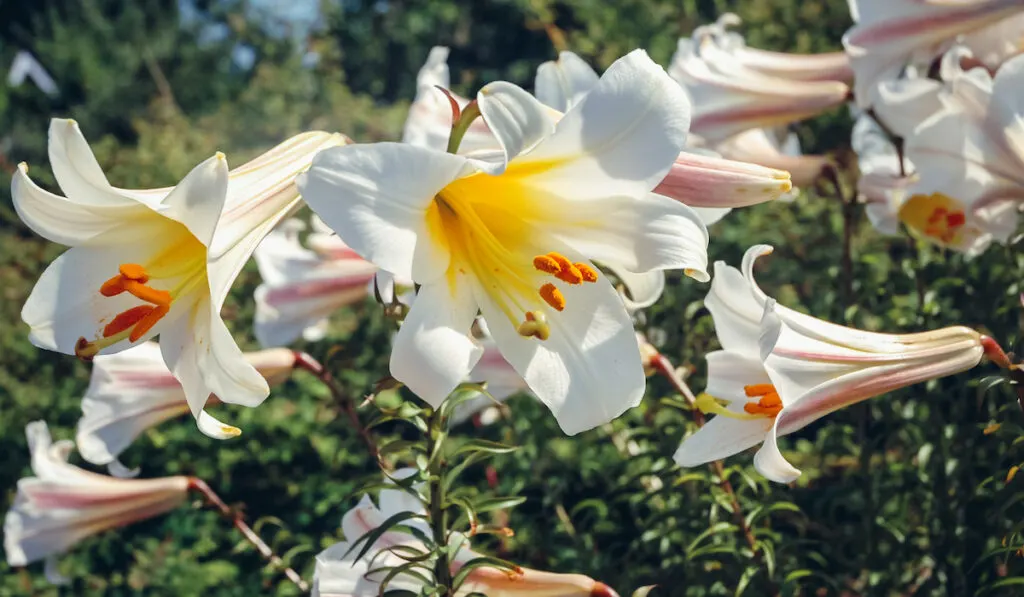
Regal lily is native to the Southwest regions of China. It has white trumpet-shaped flowers similar to those on the Easter lily. Regal lilies bloom in the middle of summer, producing 6-inch-long flowers.
Unlike Easter lilies, Regal lilies grow taller and require support for their stems. At their peak, they can grow to around 3-5 feet tall.
Regal lilies are found in USDA growing zones 4-8.
How to Care for Regal Lily
Regal lilies are not difficult to care for. Once they begin to grow, they do not require much maintenance, provided the soil remains moist.
Regal lily has tall stems, but they are sturdy, and staking is not always required. You may only need to stake if the plant has no protection from wind. Once the blooms fade, remove them and mulch around the soil to keep the root zone cool.
Calla Lilies

Calla lilies are indigenous to Africa, but they grow in some other tropical climates. In some parts of the Southern United States and Western Australia, they may be considered invasive.
Calla lilies have pleasantly-shaped flowers used in beautiful home gardens and for uncommon bouquets.
They bloom in the summer producing white, yellow, pink, orange, maroon, or coral-colored blooms. When Calla lilies mature, they can grow around 2-3 feet tall and 1-2 feet wide.
Calla lilies are found in USDA growing zones 8-10.
How to Care for Calla Lilies
Calla lilies are grown from a rhizome, not from a bulb, meaning that they are not true lilies. In the summer, they die back and regrow every year.
Do not overwater Calla lilies, especially when they are newly planted. But once established, you can water once a week or more if the weather is super hot.
When potted indoors, Calla lilies require constant moisture because pots dry faster than outdoor soil.
‘Silk Road’

‘Silk Road’ lily, also called ‘Friso’, is a white-flowered lily with a crimson red throat. This lily begins to bloom from mid-summer to late summer.
When ‘Silk Road’ matures, it can grow around 4-7 feet tall with a spread of 2-3 feet. It is found in USDA growing zones 4-8.
How to Care for ‘Silk Road’
‘Silk Road’ is a low-maintenance plant, so it is easy to care for. It requires moist, well-drained soil to thrive. Plus, it should be planted in areas with full to partial exposure to sunlight.
Mulch around the base of the plant to keep the root zone cool. Bulbs require even moisture throughout the year so ensure the soil does not dry out.
As the flowers fade, remove them to prevent the seed from setting. Once the bloom period is over, cut back the plant after the stems and leaves have turned yellow. Taller ‘Silk Road’ lilies may require staking.
Resources
- https://www.almanac.com/plant/lilies
- https://www.gardeningchores.com/types-of-lilies/
- https://www.flowerglossary.com/types-of-lilies/
- https://www.thespruce.com/growing-madonna-lily-lilium-candidum-5100935
- https://www.gardeningknowhow.com/ornamental/bulbs/lily/oriental-lily-plant-care.htm
- https://www.backyardgardener.com/plantname/lilium-bright-star-lily/
- https://www.thespruce.com/caring-for-easter-lilies-1403159
- http://www.missouribotanicalgarden.org/PlantFinder/PlantFinderDetails.aspx?taxonid=282318
- https://www.farmergracy.co.uk/products/lily-lady-alice-semi-turks-cap-bulbs-uk
- https://www.thespruce.com/grow-calla-lily-indoors-1902501
- https://www.gardeningknowhow.com/ornamental/bulbs/regal-lily/growing-regal-lilies.htm
- https://www.thespruce.com/growing-casa-blanca-lily-5115552
- https://www.gardeningknowhow.com/ornamental/bulbs/lily/growing-tree-lily-bulbs.htm
- https://www.missouribotanicalgarden.org/PlantFinder/PlantFinderDetails.aspx?taxonid=256259&isprofile=0&
